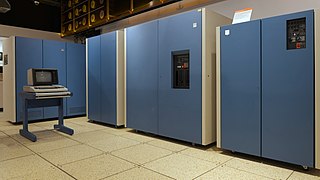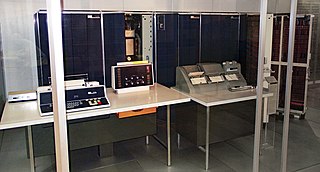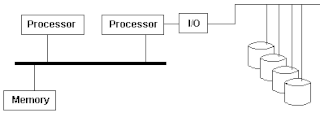IBM mainframes are large computer systems produced by IBM since 1952. During the 1960s and 1970s, IBM dominated the computer market with the 7000 series and the later System/360, followed by the System/370. Current mainframe computers in IBM's line of business computers are developments of the basic design of the System/360.

Multiple Virtual Storage, more commonly called MVS, is the most commonly used operating system on the System/370, System/390 and IBM Z IBM mainframe computers. IBM developed MVS, along with OS/VS1 and SVS, as a successor to OS/360. It is unrelated to IBM's other mainframe operating system lines, e.g., VSE, VM, TPF.

The IBM System/360 (S/360) is a family of mainframe computer systems announced by IBM on April 7, 1964, and delivered between 1965 and 1978. System/360 was the first family of computers designed to cover both commercial and scientific applications and a complete range of applications from small to large. The design distinguished between architecture and implementation, allowing IBM to release a suite of compatible designs at different prices. All but the only partially compatible Model 44 and the most expensive systems use microcode to implement the instruction set, featuring 8-bit byte addressing and fixed point binary, fixed point decimal and hexadecimal floating-point calculations.

The IBM System/370 (S/370) is a range of IBM mainframe computers announced as the successors to the System/360 family on June 30, 1970. The series mostly maintains backward compatibility with the S/360, allowing an easy migration path for customers; this, plus improved performance, were the dominant themes of the product announcement.

The IBM 700/7000 series is a series of large-scale (mainframe) computer systems that were made by IBM through the 1950s and early 1960s. The series includes several different, incompatible processor architectures. The 700s use vacuum-tube logic and were made obsolete by the introduction of the transistorized 7000s. The 7000s, in turn, were eventually replaced with System/360, which was announced in 1964. However the 360/65, the first 360 powerful enough to replace 7000s, did not become available until November 1965. Early problems with OS/360 and the high cost of converting software kept many 7000s in service for years afterward.

VM is a family of IBM virtual machine operating systems used on IBM mainframes System/370, System/390, zSeries, System z and compatible systems, including the Hercules emulator for personal computers.

The IBM 4300 series are mid-range systems compatible with System/370 that were sold from 1979 through 1992. They featured modest electrical and cooling requirements, and thus did not require a data center environment. They had a disruptive effect on the market, allowing customers to provide internal IBM computing services at a cost point lower than commercial time-sharing services. All 4300 processors used a 3278-2A, 3279-C or 3205 display console rather than a 3210 or 3215 keyboard/printer console.

IBM 7070 is a decimal-architecture intermediate data-processing system that was introduced by IBM in 1958. It was part of the IBM 700/7000 series, and was based on discrete transistors rather than the vacuum tubes of the 1950s. It was the company's first transistorized stored-program computer.
The IBM 2780 and the IBM 3780 are devices developed by IBM for performing remote job entry (RJE) and other batch functions over telephone lines; they communicate with the mainframe via Binary Synchronous Communications and replaced older terminals using synchronous transmit-receive (STR). In addition, IBM has developed workstation programs for the 1130, 360/20, 2922, System/360 other than 360/20, System/370 and System/3.

OS/360, officially known as IBM System/360 Operating System, is a discontinued batch processing operating system developed by IBM for their then-new System/360 mainframe computer, announced in 1964; it was influenced by the earlier IBSYS/IBJOB and Input/Output Control System (IOCS) packages for the IBM 7090/7094 and even more so by the PR155 Operating System for the IBM 1410/7010 processors. It was one of the earliest operating systems to require the computer hardware to include at least one direct access storage device.

An asymmetric multiprocessing system is a multiprocessor computer system where not all of the multiple interconnected central processing units (CPUs) are treated equally. For example, a system might allow only one CPU to execute operating system code or might allow only one CPU to perform I/O operations. Other AMP systems might allow any CPU to execute operating system code and perform I/O operations, so that they were symmetric with regard to processor roles, but attached some or all peripherals to particular CPUs, so that they were asymmetric with respect to the peripheral attachment.
Beginning with its 1964 System/360 announcement, IBM's mainframes initially accessed count key data (CKD) subsystems via a channel connected to separate Storage Control Units (SCUs) with attached Direct Access Storage Devices (DASD), typically a hard disk drive. This practice continued in IBM's larger mainframes thru IBM Z; however low end systems generally used lower cost integrated attachments where the function of the SCU was combined with that of the channel, typically called an Integrated File Adapter.
The IBM 3090 family is a family of mainframe computers that was a high-end successor to the IBM System/370 series, and thus indirectly the successor to the IBM System/360 launched 25 years earlier.

The IBM System/360 Model 65 is a member of the IBM System/360 family of computers. It was announced April 1965, and replaced two models, the Model 60 and Model 62, announced one year prior but never shipped. It was discontinued in March 1974.

The IBM System/370 Model 155 were jointly announced Jun 30, 1970 as "designed for ... the Seventies." That same day IBM announced the 370/195. They were the first three models of the IBM System/370 line of computers.

The IBM System/370 Model 165 were jointly announced June 30, 1970 as "designed for ... the Seventies." That same day IBM announced the 370/195. They were the first three models of the IBM System/370 line of computers.

The IBM System/370 Model 135 was announced March 8, 1971, the only 370 introduced that year. The 135 was IBM's fifth System 370, and it was withdrawn October 16, 1979.

The IBM 303X is a discontinued line of mainframe computers, the first model of which, the IBM 3033 Processor, nicknamed "The Big One", was introduced March 25, 1977.

Bus and Tag is an "IBM standard for a computer peripheral interface", and was commonly used to connect their mainframe computers to peripheral devices such as line printers, disk storage, magnetic tape drives and IBM 3270 display controllers. The technology uses two sets of thick, multi-connector copper cables, one set, carrying data, called the bus, and the other set, carrying control information, called the tag.














